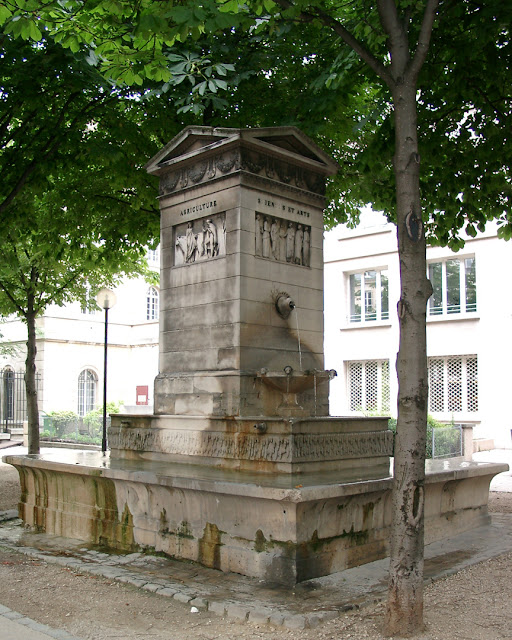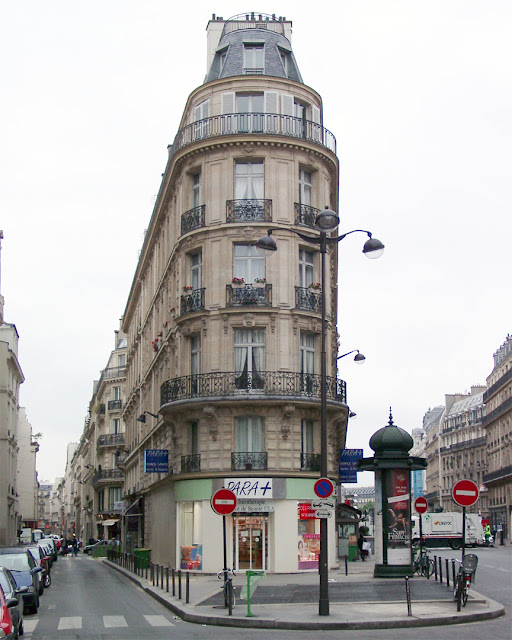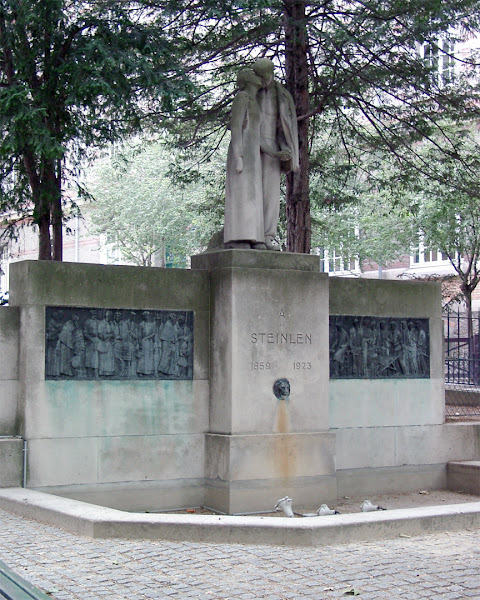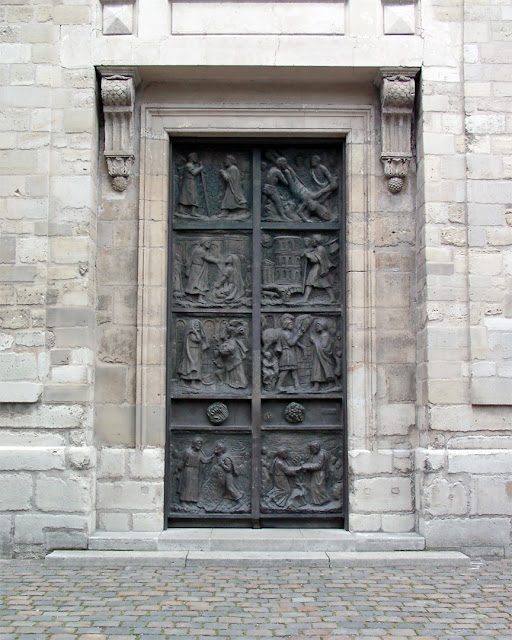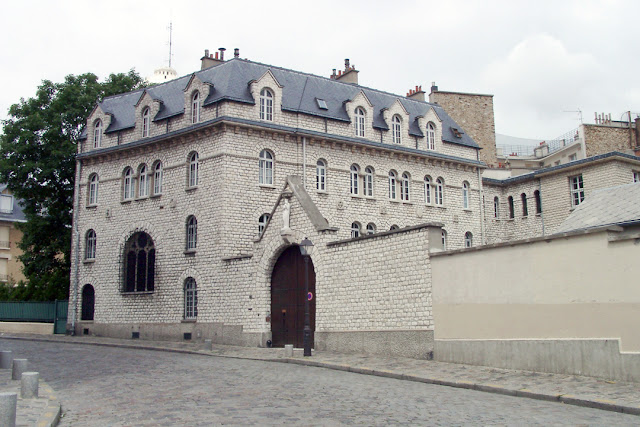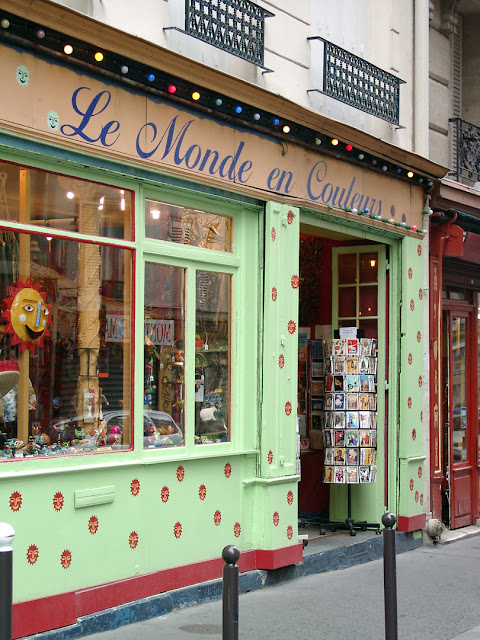Tuesday, January 31, 2006
Pierre Mendès France
Pierre Mendès France by Pierre Peignot, 1984
Jardin du Luxembourg
Quartier de l'Odéon, 6th arrondissement
Paris, July 2005
Monday, January 30, 2006
Hommage à Paul Eluard
Le poète or Hommage à Paul Eluard by Ossip Zadkine, 1954
Jardin du Luxembourg
Quartier de l'Odéon, 6th arrondissement
Paris, July 2005
Sunday, January 29, 2006
L'abri des surveillants
L'abri des surveillants (The cabin of the supervisors)
Jardin du Luxembourg
Quartier de l'Odéon, 6th arrondissement
Paris, July 2005
Saturday, January 28, 2006
Palais du Luxembourg
Palais du Luxembourg (Luxembourg Palace)
Jardin du Luxembourg
Quartier de l'Odéon, 6th arrondissement
Paris, July 2005
“The Luxembourg Palace (Palais du Luxembourg) is located at 15 Rue de Vaugirard in the 6th arrondissement of Paris. It was originally built (1615–1645) to the designs of the French architect Salomon de Brosse to be the royal residence of the regent Marie de' Medici, mother of King Louis XIII. After the Revolution it was refashioned (1799–1805) by Jean Chalgrin into a legislative building and subsequently greatly enlarged and remodeled (1835–1856) by Alphonse de Gisors. The palace has been the seat of the upper houses of the various French national legislatures (excepting only the unicameral National Assembly of the Second Republic) since the establishment of the Sénat conservateur during the Consulate; as such, it has been home to the Senate of the Fifth Republic since its establishment in 1958.” (Luxembourg Palace, Wikipedia)
Friday, January 27, 2006
L'Acteur grec
L'Acteur grec by Charles-Arthur Bourgeois, 1868
Jardin du Luxembourg
Quartier de l'Odéon, 6th arrondissement
Paris, July 2005
Thursday, January 26, 2006
Polyphemus
“Polyphème surprenant Galatée dans les bras d'Acis”
(Polyphemus Surprising Acis and Galatea) by Auguste Ottin, 1866
Fontaine Médicis (Medici Fountain)
Jardin du Luxembourg
Quartier de l'Odéon, 6th arrondissement
Paris, July 2005
“Since the fountain no longer stood against a wall, the Fontaine de Léda, displaced from another neighborhood, was placed directly behind it. (See the Fountain of Leda, below.) He replaced the two original statues of nymphs at the top of the statue with two new statues, representing the Rivers Rhone and Seine. He restored the coat of arms of the Medici family over the fountain, which had been defaced during the Revolution. He inserted two statues into the niches, one representing a faun and the other a huntress, above which are two masks, one representing comedy and the other tragedy. He removed the simple basin and water spout which had been in the niche and replaced them with a long tree-shaded basin. Finally, he removed the statue of Venus and replaced her with a group of statues by Auguste Ottin, representing the giant Polyphemus, in bronze, discovering the lovers Acis and Galatea, in white marble. That is the fountain as it appears today.” (Medici Fountain, Wikipedia)
Wednesday, January 25, 2006
Tuesday, January 24, 2006
Fontaine de la Paix
Fontaine de la Paix
Promenade de l'allée du Séminaire
Rue Bonaparte
Quartier de l'Odéon, 6th arrondissement
Paris, July 2005
Monday, January 23, 2006
Pour l’unité
“Pour l'unité du monde par l’Église catholique”
Rue Palatine
Quartier de l'Odéon, 6th arrondissement
Paris, July 2005
Sunday, January 22, 2006
Saturday, January 21, 2006
Protestant Redemption Church
Protestant Redemption Church, 1843
Rue Chauchat
Quartier du Faubourg-Montmartre, 9th arrondissement
Paris, July 2005
“The Protestant Redemption Church (église évangélique de la Rédemption), also named the Redemption Temple (Temple de la Rédemption) or simply La Rédemption, is a Lutheran parish in the 9th arrondissement of Paris, France. It is affiliated with the United Protestant Church of France. The church was established in a former 90-meter-long unloading hall built between 1821 and 1825 by architect Louis-Adrien Lusson. Later it was moved to another building at Quai de Jemmapes. In 1837, Protestant Princess Helene of Mecklenburg-Schwerin married King Louis Philippe I's son Ferdinand Philippe at the Redemption Church. She was a co-founder of the church which she attended regularly. Between 1841 and 1843, German architect Franz Christian Gau made extensive alterations to the building while keeping its four bays. After Gau's death, the works were ended by Théodore Ballu. In 1873, Paul Gauguin married a young Dane, Mette-Sophie Gad (1850–1920), at the Redemption Temple. The funeral of Baron Georges-Eugène Haussmann took place on January 15th, 1891 in the church. Haussmann was a regular parishioner of the Redemption Church.” (Protestant Redemption Church, Wikipedia)
Friday, January 20, 2006
Thursday, January 19, 2006
Rue des Filles-Saint-Thomas
Corner building
Rue des Filles-Saint-Thomas / Rue du Quatre-Septembre
Quartier Vivienne, 2nd arrondissement
Paris, July 2005
Wednesday, January 18, 2006
Saint-Jean de Montmartre
Saint-Jean de Montmartre
Rue des Abbesses
Quartier des Grandes-Carrières, 18th arrondissement
Paris, July 2005
“Saint-Jean de Montmartre is a Roman Catholic parish church located at 19 Rue des Abbesses in the 18th arrondissement of Paris. Situated at the foot of Montmartre, it is notable as the first example of reinforced concrete in church construction. Built from 1894 through 1904, it was designed by architect Anatole de Baudot, a student of Viollet-le-Duc and Henri Labrouste. The brick and ceramic tile-faced structure exhibits features of Art Nouveau design while exploiting the superior structural qualities of reinforced concrete with lightness and transparency. The Art Nouveau stained glass was executed by Jac Galland according to the design of Pascal Blanchard. Interior sculpture was by Pierre Roche. The reinforced concrete structure followed a system developed by the engineer Paul Cottancin. Construction was attended by skepticism over the properties of the new material, which violated rules laid down for unreinforced masonry construction. A lawsuit delayed construction, resulting in a demolition order that was not resolved until 1902, when construction was resumed.” (Saint-Jean de Montmartre, Wikipedia)
Tuesday, January 17, 2006
Rue André-Antoine
Corner building
Rue André-Antoine
Quartier des Grandes-Carrières, 18th arrondissement
Paris, July 2005
Monday, January 16, 2006
Maison Eymonaud
Maison Eymonaud (hôtel de l'Escalopier)
Impasse Marie-Blanche
Quartier des Grandes-Carrières, 18th arrondissement
Paris, July 2005
Sunday, January 15, 2006
Saturday, January 14, 2006
Rue Tourlaque
Corner building
Rue Caulaincourt / Rue Tourlaque
Quartier des Grandes-Carrières, 18th arrondissement
Paris, July 2005
Friday, January 13, 2006
Thursday, January 12, 2006
René Dumesnil
Grave of René Dumesnil (1879-1967)
Cimetière Saint-Vincent (Saint-Vincent Cemetery)
Rue Lucien-Gaulard
Quartier des Grandes-Carrières, 18th arrondissement
Paris, July 2005
“René Dumesnil (19 June 1879 – 24 December 1967) was a French physician, literary critic and musicologist. Dumesnil studied literature at the Sorbonne and became a literary critic. Then he was music critic for Le Mercure de France and Le Monde. He was elected a member of the Académie des beaux-arts in 1965. In addition to his publications in literature (numerous studies on Flaubert, Maupassant and realism, he has written a number of books on music. Dumesnil won four prizes awarded by the Académie française.” (René Dumesnil, Wikipedia)
Wednesday, January 11, 2006
Marcel Carné
Grave of Marcel Carné (1906-1996)
Cimetière Saint-Vincent (Saint-Vincent Cemetery)
Rue Lucien-Gaulard
Quartier des Grandes-Carrières, 18th arrondissement
Paris, July 2005
“Marcel Albert Carné (18 August 1906 – 31 October 1996) was a French film director. A key figure in the poetic realism movement, Carné's best known films include Port of Shadows (1938), Le Jour Se Lève (1939), The Devil's Envoys (1942) and Children of Paradise (1945), the last of which has been cited as one of the greatest films of all time.” (Marcel Carné, Wikipedia)
Tuesday, January 10, 2006
Théophile Steinlen
Monument to Théophile Steinlen by Paul Vannier, 1936
Square Joël-Le Tac
Place Constantin-Pecqueur
Quartier des Grandes-Carrières, 18th arrondissement
Paris, July 2005
“Théophile Alexandre Steinlen (November 10, 1859 – December 13, 1923), was a Swiss-born French Art Nouveau painter and printmaker. Born in Lausanne, Switzerland, Steinlen studied at the University of Lausanne before taking a job as a designer trainee at a textile mill in Mulhouse in eastern France. In his early twenties he was still developing his skills as a painter when he and his wife Emilie were encouraged by the painter François Bocion to move to the artistic community in the Montmartre Quarter of Paris. Once there, Steinlen was befriended by the painter Adolphe Willette who introduced him to the artistic crowd at Le Chat Noir that led to his commissions to do poster art for the cabaret owner/entertainer, Aristide Bruant and other commercial enterprises.” (Théophile Steinlen, Wikipedia)
Monday, January 9, 2006
Place du Tertre
Signs and plaques
Place du Tertre, Montmartre
Quartier de Clignancourt, 18th arrondissement
Paris, July 2005
“The Place du Tertre is a square in the 18th arrondissement of Paris, France. Only a few streets away from Montmartre's Basilica of the Sacré Cœur and the Lapin Agile, it is near the summit of the city's elevated Montmartre quarter. Place du Tertre was the heart of the prestigious Benedictine Montmartre Abbey, established in 1133 by King Louis VI. Montmartre Abbey thrived through the centuries and until the French revolution under the patronage of the Kings of France. Place du Tertre was opened to the public in 1635 as Montmartre village central square. From the end of the 18th century until World War One, the whole Montmartre Boheme could be seen here: painters, songwriters and poets.” (Place du Tertre, Wikipedia)
Sunday, January 8, 2006
Bronze portal
Bronze portal by Tommaso Gismondi, 1980
Saint-Pierre de Montmartre
Rue du Mont-Cenis, Montmartre
Quartier de Clignancourt, 18th arrondissement
Paris, July 2005
Saturday, January 7, 2006
Saint-Pierre de Montmartre
Saint-Pierre de Montmartre
Rue du Mont-Cenis, Montmartre
Quartier de Clignancourt, 18th arrondissement
Paris, July 2005
“Saint-Pierre de Montmartre is one of the oldest surviving churches in Paris but the lesser known of the two main churches in Montmartre, the other being the more famous 19th-century Sacré-Cœur Basilica. Saint-Pierre de Montmartre, built in 1147, was the church of the prestigious Montmartre Abbey. According to the earliest biography of Saint Ignatius Loyola, the martyrium of Montmartre Abbey was the location at which the vows were taken that led to the founding of the Society of Jesus.” (Saint-Pierre de Montmartre, Wikipedia)
Friday, January 6, 2006
Carmel de Montmartre
Carmel de Montmartre
Rue du Chevalier-de-La-Barre, Montmartre
Quartier de Clignancourt, 18th arrondissement
Paris, July 2005
Thursday, January 5, 2006
Rue Poulet
Corner building
Rue Poulet / Rue Myrha
Quartier de Clignancourt, 18th arrondissement
Paris, July 2005
Wednesday, January 4, 2006
Grands Magasins Dufayel
Grands Magasins Dufayel
Rue de Clignancourt
Quartier de Clignancourt, 18th arrondissement
Paris, July 2005
Tuesday, January 3, 2006
Monday, January 2, 2006
Le Monde en Couleurs
Le Monde en Couleurs
Rue André del Sarte, Montmartre
Quartier de Clignancourt, 18th arrondissement
Paris, July 2005
Sunday, January 1, 2006
Les escaliers de la Butte
Les escaliers de la Butte
Rue Foyatier
Quartier de Clignancourt, 18th arrondissement
Paris, July 2005
Subscribe to:
Posts (Atom)








